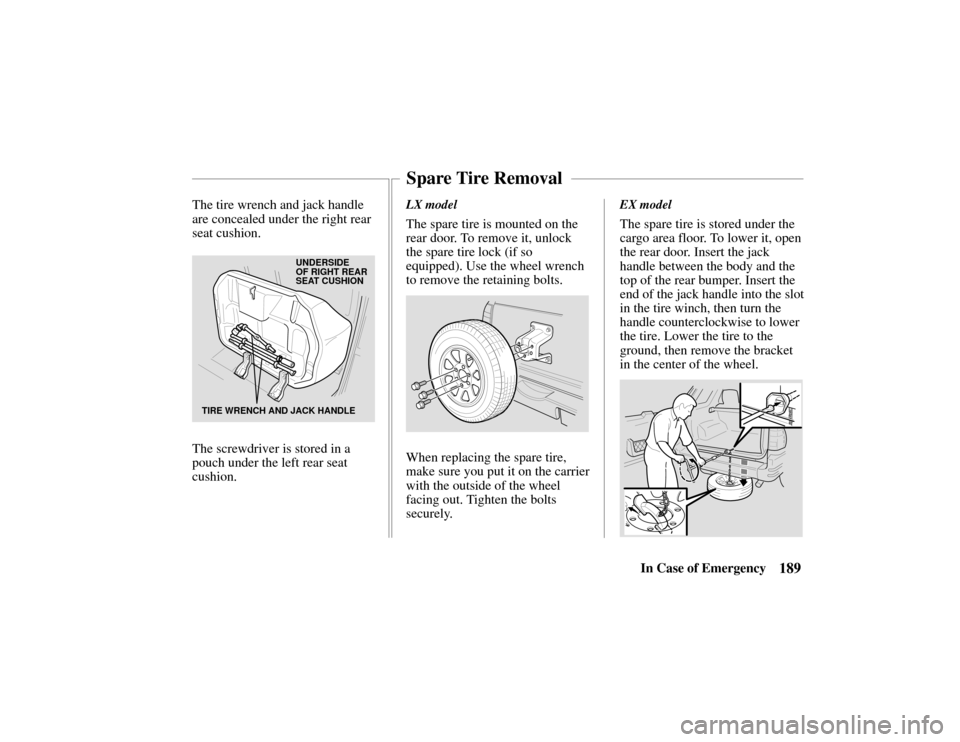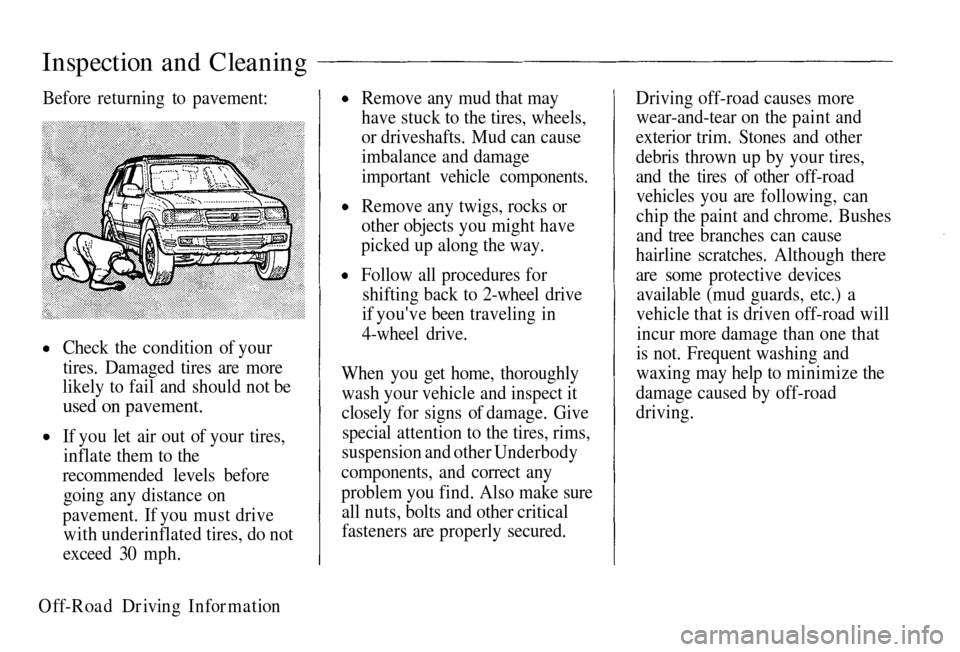wheel bolts HONDA PASSPORT 2002 2.G Owners Manual
[x] Cancel search | Manufacturer: HONDA, Model Year: 2002, Model line: PASSPORT, Model: HONDA PASSPORT 2002 2.GPages: 294, PDF Size: 3.97 MB
Page 192 of 294

189In Case of Emergency
The tire wrench and jack handle
are concealed under the right rear
seat cushion.
UNDERSIDE
OF RIGHT REAR
SEAT CUSHION
TIRE WRENCH AND JACK HANDLE
The screwdriver is stored in a
pouch under the left rear seat
cushion.
LX model
The spare tire is mounted on the
rear door. To remove it, unlock
the spare tire lock (if so
equipped). Use the wheel wrench
to remove the retaining bolts.
When replacing the spare tire,
make sure you put it on the carrier
with the outside of the wheel
facing out. Tighten the bolts
securely.
EX model
The spare tire is stored under the
cargo area floor. To lower it, open
the rear door. Insert the jack
handle between the body and the
top of the rear bumper. Insert the
end of the jack handle into the slot
in the tire winch, then turn the
handle counterclockwise to lower
the tire. Lower the tire to the
ground, then remove the bracket
in the center of the wheel.
Spare Tire Removal
Page 225 of 294

222Care and Maintenance
Front (4WD Only) and Rear
Propeller Shaft
Lubricate the sliding yoke with
EP chassis grease. Lubricate
universal joints with grease
containing MoS
2 (molybdenum
disulfide-type grease) at the
intervals shown in the
Maintenance Schedule. Also
check the propeller shaft
flange-to-pinion bolts for proper
torque of 64 N⋅ m (46.3 lb-ft).
Most lubrication recommendations
and procedures for four-wheel drive-
equipped vehicles are the same
for the corresponding components
in conventional drive vehicles.
Exhaust System
Check the complete exhaust
system and nearby body areas for
damaged, missing, or
mispositioned parts, open seams, holes, loose connections, or other
deterioration that could allow
exhaust fumes to seep into the
passenger compartment or cause
heat build-up in the floor pan. Any
necessary corrections should be
made immediately. For continued
safety, exhaust system pipes and
resonators rearward of the muffler
must be replaced whenever a new
muffler is installed.
Fuel Line and Fuel Tank/Cap
Inspect the fuel tank, cap and lines
for damage that could cause
leakage. Inspect the fuel cap and
gasket for correct sealing ability
and indications of physical
damage. Replace any damaged or
malfunctioning parts.
Drive Belt
Check the belt driving the
alternator, power steering pump,
and air conditioning compressor.
Look for cracks, fraying, and
wear. Replace as necessary.
Timing Belt
The timing belt should normally
be replaced at the intervals shown
in the Maintenance Schedule.
Valve Clearance
Incorrect valve clearance will
result in increased engine noise
and lower engine output, thereby
adversely affecting engine
performance.
Page 294 of 294

Inspection and Cleaning
Check the condition of your
tires. Damaged tires are more
likely to fail and should not be
used on pavement.
If you let air out of your tires,inflate them to the
recommended
levels before
going
any distance on
pavement.
If you must drive
wit
h underinflated tires, do not
exceed
30 mph. Remove
any mud that may
have
stuck to the tires, wheels,
or driveshafts. Mud can cause
imbalance
and damage
important vehicle components.
Remove any twigs, rocks or
other objects you might have
picked up along the way.
Follow
all procedures for
shifting back to 2-wheel drive
if you've been traveling in
4-wheel
drive.
When you get home, thoroughly wash your vehicle and inspect it
closely
for signs of damage. Give
special attention to the tires, rims,
suspension and other Underbody
components, and correct any
problem you find. Also make sure all
nuts, bolts and other critical
fasteners
are properly secured. Driving off-road causes more
wear-and-tear
on the paint and
exterior trim. Stones and other debris
thrown up by your tires,
and
the tires of other off-road
vehicles you are following, can
chip
the paint and chrome. Bushes
and tree branches can cause
hairline
scratches. Although there
are some protective devices available
(mud guards, etc.) a
vehicle that is driven off-road will
incur
more damage than one that
is not. Frequent washing and
waxing may help to minimize the
damage caused by off-road
driving.
Befor
e returning to pavement:
Off-Road Driving Information